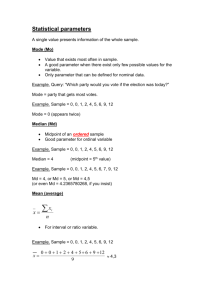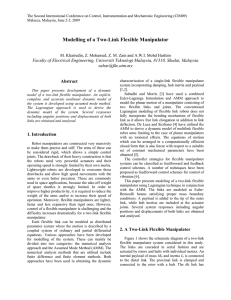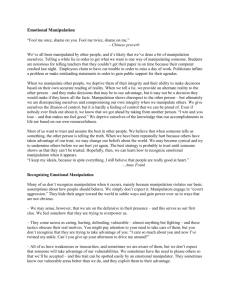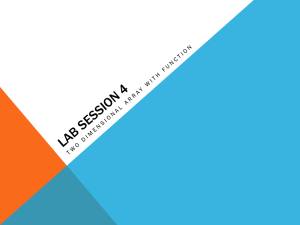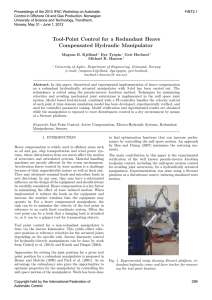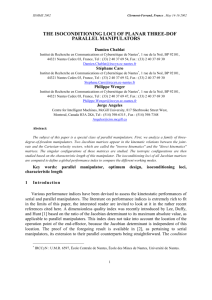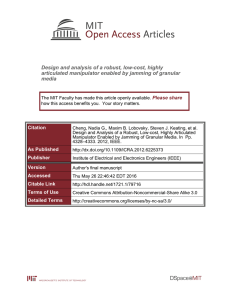Solution
advertisement
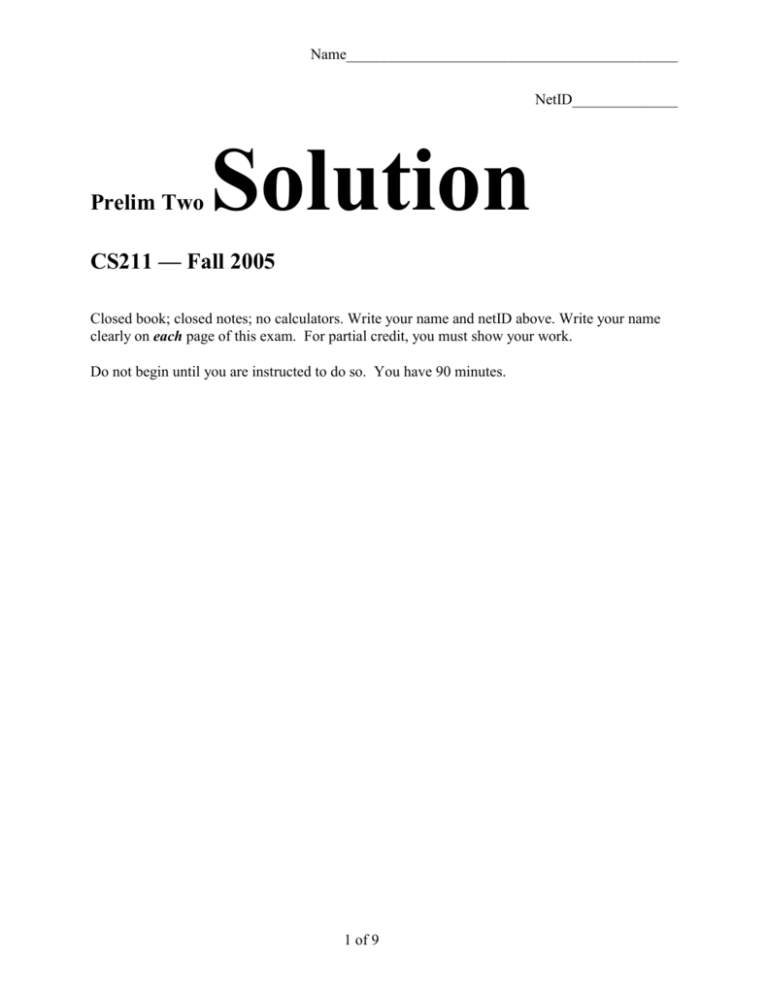
Name____________________________________________
NetID______________
Prelim Two
Solution
CS211 — Fall 2005
Closed book; closed notes; no calculators. Write your name and netID above. Write your name
clearly on each page of this exam. For partial credit, you must show your work.
Do not begin until you are instructed to do so. You have 90 minutes.
1 of 9
Name____________________________________________
1. (22 points; 2 each) True or false?
a) T F The expected runtime for QuickSort is O(n log n) and the expected runtime for
InsertionSort is O(n2), so QuickSort is always better than InsertionSort.
b) T F QuickSort is a stable sorting algorithm.
c) T F In a Binary Search Tree (BST) with n nodes, it always takes O(log n) time in the
worst-case to find a node.
d) T
F A binary tree of height h has O(2h) nodes.
e) T F QuickSort's efficiency always improves if you pick the largest element as your
pivot instead of the smallest element.
f) T
F If f(n) = n2log n + 2n + 2 then we know that f(n) is O(n3).
g) T
F If f(n) = O(g(n)) and g(n) = O(h(n)) then we know that f(n) = O(h(n)).
h) T F f(n) + g(n) is O(min{f(n), g(n)}).
i) T
F If f(n) is O(n2) and g(n) is O(n) then we know that f(n) + g(n) is O(n2).
j) T F If item A is an ancestor of item B in a Binary Search Tree (BST) used as a
Dictionary (operations = insert, find, remove) then it must be the case that the Insert
operation for item A occurred before the Insert operation for item B.
k) T
F Both QuickSort and MergeSort use the Divide-and-Conquer strategy.
2. (BSTs; 8 points; 2 each)
Suppose we wish to search for the number 400 in a Binary Search Tree (BST) holding integers.
For each of the following sequences, can it be the sequence of nodes examined during a search
for 400 in some BST? Answer yes or no; no proof is required.
a. 150, 490, 312, 440, 301, 322, 400
no (because of 301)
b. 101, 102, 103, 100, 200, 300, 400
no (because of 100)
c. 150, 600, 200, 230, 250, 450, 350, 400
yes
d. 150, 200, 250, 300, 450, 350, 500, 400
no (because of 500)
2 of 9
Name____________________________________________
3. (Heaps; 10 points)
In lecture, we discussed two ways of building a heap: (1) inserting elements one at a time and (2)
constructing the heap in-place from the bottom up. Using either of these two methods, what is
the result of building a max-heap on the array A = {5, 3, 17, 10, 84, 19, 6, 22, 9}? Show your
heap as a tree (even though it is really stored in an array). [It is possible to receive partial credit,
but only if you show your work.]
Using BuildHeap (bottom-up):
84
/
22
/
\
10
3
/ \
5
9
\
19
/
17
\
6
Using one-at-a-time insertion:
84
/
\
22
19
/
\
/
\
17
10 5
6
/ \
3
9
3 of 9
Name____________________________________________
4. (Big-O; 15 points; 5 each)
a. Write a clear definition of what it means for f(n) to be O(g(n)).
There are constants c and N such that f(n) < cg(n) for all n > N.
Alternate: the limit as n goes to infinity of f(n)/g(n) exists. [Technically, this definition
requires that f and g are monotone increasing functions.]
b. Prove or disprove: log n is O(log(2n)). If it's true find a witness pair, otherwise provide a
counterexample.
We know: log n < 1 + log n = log 2 + log n = log(2n) and that this holds for all values of
n>0. Thus, by definition log n is O(log(2n)) for witness pair (c=1, N=0).
c. Prove or disprove. If f(n) is O(n) and g(n) is O(n2) then f(n)=O(g(n)). If it's true find a
witness pair, otherwise provide a counterexample.
Counterexample: Let f(n) = n and let g(n) = log n. Note that g(n) is O(n2) because big-O
provides an upper bound.
4 of 9
Name____________________________________________
5. (Inheritance; 10 points)
You are designing a system that works on a given double value using a “pipeline” of
manipulators.
The system receives an array of Manipulator objects; this array determines the set of operations
that are applied to a double. For example, one Manipulator object may square the double, another
Manipulator may divide it by two.
The following Java code snippet shows how an array of Manipulator objects is used to perform
the default manipulation (truncate the double, throwing away the decimal part), add one to the
given value, square it, and then take the base 8 logarithm.
public static void main(String [] args) {
if (args.length == 0) System.exit(0); //quit
Manipulator[] mArray = new Manipulator[] {
new Manipulator(),
new AddOneManipulator(),
new SquareManipulator(),
new LogarithmManipulator(8.0)
};
process(mArray, Double.parseDouble(args[0]));
}
public static double process(Manipulator[] manipulators, double value) {
for (Manipulator m : manipulators) {
value = m.manipulate(value);
}
return value;
}
Write the Java class declarations for Manipulator, AddOneManipulator, SquareManipulator, and
LogarithmManipulator. You may use the methods Math.floor(double value) which computes the
floor of the value and Math.log10(double value) which returns the base-10 logarithm of the
value. To find a logarithm of some value to base b, use Math.log10(value)/Math.log10(b).
Use the next page to write your Java classes.
5 of 9
Name____________________________________________
Use this page to write the classes Manipulator, AddOneManipulator, SquareManipulator, and
LogarithmManipulator for problem 5.
class Manipulator {
public double manipulate (double value) {
return Math.floor(value);
}
}
class AddOneManipulator extends Manipulator {
public double manipulate (double value) {
return value + 1;
}
}
class SquareManipulator extends Manipulator {
public double manipulate (double value) {
return value*value;
}
}
class LogarithmManipulator extends Manipulator {
private double base;
public LogarithmManipulator (double base) {
this.base = base;
}
public manipulator (double value) {
return Math.log10(value)/Math.log10(base);
}
}
6 of 9
Name____________________________________________
6. (Data Structures; 20 points; 4 each)
For each of the following pairs of data structures, name one advantage that the first data structure
has over the second and one advantage that the second has over the first. Your answers should
be brief. Note that "having more operations" is not an acceptable answer since the given
Abstract Data Type (ADT) determines the set of operations. Further, note that we are assuming
high-quality implementations are readily available, so “easier to implement” is also not an
acceptable answer
a. [Linked List vs. Array] used as a Stack.
Linked List advantage: No bound on size
Array advantage: Less space
b. [Heap vs. Sorted Array] used as a Priority Queue.
Heap advantage: All PQ operations are O(log n) time.
Sorted Array advantage: Fast if no insertions after initialization or getMax takes O(1)
time.
c. [Hashing with Chaining and Table-Doubling vs. Balanced BST] used as a Dictionary.
Hashing advantage: O(1) expected time (but bad worst-case)
Balanced BST advantage: O(log n) worst-case time
d. [Array of Lists, one list for each priority (sometimes called a bounded-height priority
queue) vs. Heap] used as a Priority Queue.
Array of Lists advantage: O(1) per operation (but requires small number of priorities) or
FIFO for items with tied priorities
Heap advantage: Can allow arbitrary number of different priorities.
e. [Sorted Array vs. Balanced BST] used as a Dictionary.
Sorted Array advantage: Uses less space
Balanced BST advantage: Insert and remove are faster (O(log n)).
7 of 9
Name____________________________________________
7. (Sorting; 10 points; 5 each)
For each of the problems below, you need to show the important steps of a sorting algorithm.
The idea is to show that you understand how the algorithm works. We are not interested in code;
just show how the data is moved during the algorithm at the level-of-detail one might use while
explaining the algorithm on a blackboard.
a. Show the important steps that occur when MergeSort is performed on the following array
of integers: {23, 15, 20, 10, 5, 78, 30, 40}.
Split: {23, 15, 20 10} {5, 78, 30, 40}
Split: {23, 15} {20, 10} {5, 78} {30, 40}
Split: 23 15 20 10 5 78 30 40
Merge: {15, 23} {10, 20} (5, 78} {30, 40}
Merge: {10, 15, 20, 23} {5, 30, 40, 78}
Merge: {5, 10, 15, 20, 23, 30, 40, 78}
b. Show the important steps that occur when SelectionSort is performed on the following
array of integers: {23, 15, 20, 10, 5, 78, 30, 40}.
Swap: {5, 15, 20, 10, 23, 78, 30, 40}
Swap: {5, 10, 20, 15, 23, 78, 30, 40}
Swap: {5, 10, 15, 20, 23, 78, 30, 40}
…
Swap: {5, 10, 15, 20, 23, 30, 78, 40}
Swap: {5, 10, 15, 20, 23, 30, 40, 78}
8 of 9
Name____________________________________________
8. (Data Structures and Runtime Analysis; 5 points)
Suppose that we are given n integers stored in a large array and that some of these integers are
duplicates. Our goal is to report the integer that appears the most often.
Briefly explain how to use a Dictionary (called a Map in Java) to solve this problem.
Include a runtime analysis assuming that the Dictionary is implemented as a Balanced BST (e.g.,
it uses a Java TreeMap). Express your answer in terms of n (the size of the original list) and k
(the number of distinct integers). Be sure to indicate whether the runtime is expected or worstcase.
Use (integer, count) as the (key, value) pairs. Every time you process an integer, look it up in the
Dictionary to get the count, increment the count by 1 and store it back in the Dictionary.
To find the max count, you can either iterate through the whole Dictionary or you can keep track
of maxCountSoFar (and the corresponding integer) as the algorithm runs.
Runtime: Dictionary holds at most k items so all operations are O(log k). There are O(n)
operations, so total time is O(n log k).
- End of Prelim 2 -
9 of 9


